

© Shipping Wonders of the World 2012-

Romance of the Chronometer
For many centuries the navigator was unable to calculate his ship’s longitude accurately because no scientist could devise a reliable means of timekeeping at sea. The problem was solved by a self-
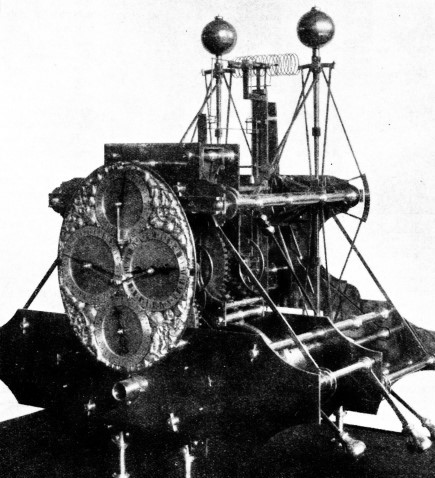
THE FIRST HARRISON CHRONOMETER uses a pair of vibrating balances to eliminate the timekeeping errors caused by the motion of a ship. Built on the lines of a large spring-
IMAGINE what a scene there would be on board a modern transatlantic liner if the captain were suddenly to inform his passengers that he was hopelessly fogged as to the ship’s position — that for all he knew or could discover, she might be about to run ashore, or might, on the other hand, be still two days’ steaming, or so, from her port. Such an occurrence would be unthinkable nowadays, but less than two centuries ago every one who went to sea accepted such a state of affairs as natural and inevitable.
Until the eighteenth century was more than half over, no navigator, once his ship had lost sight of land, could determine her position with any accuracy at all. Before he could accomplish this he had to find, by observation, his latitude and his longitude. Although navigators had been able, since Columbus’s time and even earlier, to determine their latitude more or less accurately by observations of the sun, no corresponding method of obtaining their longitude existed in practice.
The utmost that they could do was to keep a reckoning of how far, judging by the ship’s speed through the water, they had made good to the eastward or westward of their starting point, and then make whatever allowance seemed most suitable for the effects of currents, leeway, bad steering, and other sources of error. In Queen Anne’s time the steady annual toll of ships and cargoes and men’s lives had come to press so heavily on the merchant and seafaring classes that in 1713 a number of shippers, shipowners and merchant captains petitioned the Crown for relief, praying that a public reward might be offered to encourage the invention of some method of finding longitude at sea. This petition was referred to a specially-
“One is, by a Watch to keep time exactly. But, by reason of the Motion of a Ship, the Variation of Heat and Cold, Wet and Dry, and the Difference of Gravity in different Latitudes, such a watch hath not yet been made.”
The Government accepted the Committee’s findings, and passed a Longitude Act offering a large reward for any generally applicable method of finding longitude at sea. If, at the end of a six weeks’ voyage the method indicated the true longitude to within 60 geographical miles, the inventor’s reward would be £10,000. If the error was less than 40 miles, the reward payable was £15,000, and if the method proved accurate to within 30 miles, £20,000 would be paid.
The Act also established a permanent body of Commissioners, charged with supervising all attempts to win the rewards, and empowered to advance small sums to help inventors whose schemes appeared sufficiently promising. They were known as the Board of Longitude.
The newly appointed Board at once became and remained the immediate and accessible target of every crank, swindler, fanatic, enthusiast and lunatic in or out of Bedlam. The public suddenly became, as the phrase is, “longitude-
In the year 1728 there journeyed to London a working carpenter, John Harrison, of Barrow-
As evidence of his abilities, Harrison brought with him specimens of two original inventions which he had successfully applied to his clocks — a form of pendulum (known, from its appearance, as the “gridiron”) composed of brass and steel rods so arranged that its period of vibration was virtually unaffected by changes of temperature; and a complicated but highly efficient escapement (known as the “grasshopper”) which never needed oiling and gave an almost continuous impulse with a minimum of friction. He had already built two clocks embodying these inventions, and they had proved themselves capable of going with unprecedented accuracy, their errors never amounting over long periods to as much as one second a month.
Before calling on the Board, Harrison visited Edmond Halley, then Astronomer Royal, and George Graham (another north-
The modern chronometer is really a large and perfect watch, but in designing No. 1, the first accurate marine timekeeper ever made, Harrison did not attempt to conform with the pocketwatches of his day. He was perfectly capable of making them and, as after events showed, of improving them; but he knew that the best of them could not be trusted even to within five minutes a day. To win the £20,000 reward the extreme permissible error was about three seconds a day — a degree of accuracy which had scarcely been reached, except for Harrison’s pair, by any clock designed for use on shore, with all the extra advantages conferred by a fixed, motionless support and by the use of a pendulum.
Harrison redesigned his improved grandfather clocks for use at sea. In doing so he grappled with and overcame difficulties which had baffled all his predecessors.
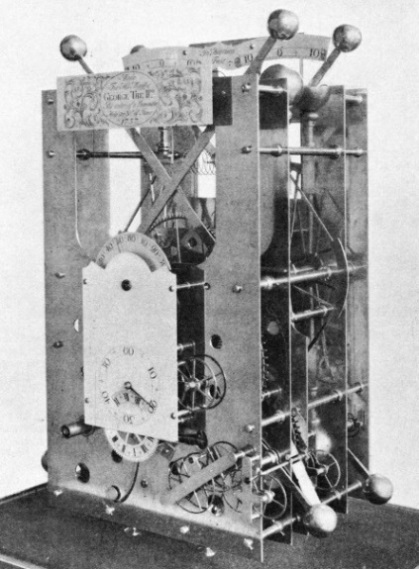 The main mechanical difficulty was twofold. A pendulum cannot be used advantageously at sea, so a marine timekeeper must be governed by a vibrating “balance”, controlled by a spring. For accurate timekeeping that balance must have a perfectly constant period of vibration. In anything but the calmest weather the incessant, varying motion of the ship would tend to alter the extent and the period of every vibration. Again, the slightest alterations of temperature would have a most marked effect upon the controlling spring — relaxing it in heat, stiffening it in cold, and causing the timekeeper to go either slow or fast. The error induced was approximately one minute a day for an alteration in temperature of only 10°.
The main mechanical difficulty was twofold. A pendulum cannot be used advantageously at sea, so a marine timekeeper must be governed by a vibrating “balance”, controlled by a spring. For accurate timekeeping that balance must have a perfectly constant period of vibration. In anything but the calmest weather the incessant, varying motion of the ship would tend to alter the extent and the period of every vibration. Again, the slightest alterations of temperature would have a most marked effect upon the controlling spring — relaxing it in heat, stiffening it in cold, and causing the timekeeper to go either slow or fast. The error induced was approximately one minute a day for an alteration in temperature of only 10°.
MORE ROBUSTLY BUILT than the first, Harrison’s second chronometer has its mechanism housed between stiff plates of brass. This model was never tried at sea, as the inventor set to work on a new timekeeper immediately after the second had been completed. No. 2 chronometer weighs 103 lb.
Harrison most ingeniously eliminated the errors caused by the ships’ motion. He replaced his pendulum, not by a single balance, but by two — a pair of huge straight-
The balances, and most of the wheels, are mounted on anti-
Having tested No. 1 successfully on board a barge in the River Humber, Harrison brought it to London in the spring of 1736. Graham, Halley and others of the Royal Society saw and praised it, and on their recommendation the Admiralty allowed it to be embarked, with its maker, on board H.M.S. Centurion (afterwards Anson’s famous ship) for a voyage to Lisbon. The chronometer was transferred to H.M.S. Orford for the return voyage, and her log (May 30, 1736) contains the first reference to Harrison in any Admiralty document.
An official certificate of No. 1’s trustworthiness was given to Harrison by the Master of the Orford.
This certificate shows clearly that No. 1’s accidental errors of timekeeping — after having allowed, as is done with all chronometers, for its ascertained rate of going — must have been trifling — a few seconds at most. Its performance was an eye-
753 Separate Parts
No. 2 was never tried at sea. Soon after having completed it, Harrison set to work on a third timekeeper of different design, which he expected to be his masterpiece, and on which he spent no fewer than seventeen years (1740-
No. 3 has a half-
In 1757-
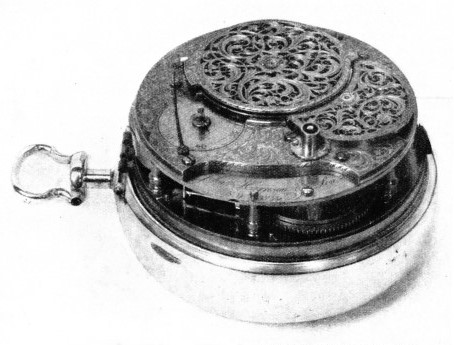
RESEMBLING A LARGE WATCH in a silver case, Harrison’s No. 4 chronometer was found to be as good a timekeeper as the earlier models, and also far less cumbersome. During a voyage to Barbados lasting five months, its total error was less than one-
No. 4 chronometer is simply a large watch in a silver case some 5 in. across. It embodies, in much reduced form, most of the principal improvements fitted in No. 3, but the anti-
In March 1761 Harrison applied officially to the Board of Longitude for a trial of No. 4 in competition for the £20,000 reward. In November of that year H.M.S. Deptford, with William Harrison and No. 4 chronometer on board, sailed for Jamaica. Captain Digges of the Deptford shaped course to touch at Madeira, and after nine days at sea the ship’s longitude, by dead reckoning, was 13° 50' W. (from Greenwich), while by No. 4 it was 15° 19' W. William Harrison, justifiably confident of No. 4’s powers, maintained forcibly that the timekeeper was correct, and that if Madeira were correctly shown on the charts they ought to sight it the following morning.
Accordingly, although Digges offered to lay five to one that No. 4 was wrong, he held on his course — and sighted Madeira next morning (December 9).
When the Deptford reached Jamaica on January 21, 1762, No. 4’s error, after allowance had been made for its declared rate, was found by observations to be five seconds, corresponding to 1¼ minutes of longitude — in the latitude of Jamaica, rather less than one geographical mile, as against the thirty allowed by the Act of Queen Anne. Accordingly, under this act Harrison be came entitled, provided that he could show his wonderful timekeeper to be a “generally practicable and useful” means of finding longitude, to the reward of £20,000. This he most thoroughly deserved, for the great and famous “problem of the longitude” which had baffled Newton, Leibniz, Halley and a hundred others, was definitely solved at last.
The Board of Longitude, however, thought otherwise. Although they advanced Harrison £2,500 on account of the full reward, they insisted on a second official trial. This, after a good deal of wrangling, took place in 1764.
William Harrison and No. 4 chronometer were sent in H.M.S. Tartar to Barbados. Its error at Barbados was found to be 38.4 seconds in seven weeks, corresponding to 9.6 geographical miles. In the round voyage its total error, allowing for changes of rate at different temperatures, was a loss of fifteen seconds in five months, or an error of less than one-
Still the Board’s doubts were not fully removed and much paper warfare ensued. Ultimately, on October 28, 1765, they paid Harrison another £7,500 — making £10,000 in all — on condition that he delivered to them, in trust for the public, all four of his timekeepers with a full description, in writing, of No. 4. They flatly refused to pay the other half of the Parliamentary reward unless and until Harrison made two more timekeepers and submitted them to such tests and official trials as they might see fit to impose.
Harrison was then over seventy, and his sight was failing. As he himself said, he regarded the second half of the reward as lost to him for ever. He made no attempt to comply with the Board’s requirements — but in 1770 he and his son managed to complete his last timekeeper. No. 5.
It was almost a duplicate of No. 4, but less ornamented, and with one or two slight mechanical improvements. In the same year Larcum Kendall, a London watchmaker, also completed a duplicate of No. 4 commissioned by the Board of Longitude. Although virtually an exact facsimile down to the smallest screw, it was even better finished. Having been sent to sea with Cook in his second (Antarctic) voyage of 1772-
Meanwhile Harrison had won his fight with the Board of Longitude. The published accounts of No. 4’s trials had reached King George III’s ears, and in due course the two Harrisons were summoned to Windsor. The old inventor told the story of his long struggle, first with the mechanical difficulties and then with the Board, to a sympathetic listener — for King George always had a warm corner in his heart for science and invention of all kinds. He was heard to remark, “These people have been cruelly wronged” — and then, explosively, “By God, Harrison, I’ll see you righted!” And thereafter he did his best to deal faithfully with the Board.
As a preliminary, No. 5 was tested at the King’s own observatory at Kew, and went for ten weeks with a total error of only 4½ seconds. This being an unofficial test, the Board declined to take it into account — whereupon Harrison, backed by the King’s Parliamentary influence, presented a petition to the House of Commons (April 1772) setting out his claim to the second half of the £20,000 reward. The Board, not expecting to find themselves on the defensive and discovering that the sense of the House was strongly against them, bowed to the storm.
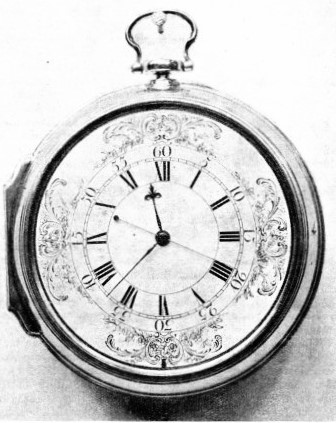
WINNER OF A £20,000 PRIZE, Harrison’s No. 4 timepiece was the subject of much wrangling between the inventor and the Board of Longitude.
A clause in a General Supply Bill finally gave Harrison, without any further delays or trials, the second £10,000, which, legally and morally, ought to have been his more than ten years earlier. He did not live long to enjoy this final triumph, dying in his house in Red Lion Square, London, on March 24, 1776, in his eighty-
His No. 5 timekeeper remained in private hands (it is now in the Guildhall), but his four earlier machines, including No. 4, the prizewinner, became national property in 1765. They were sent to Greenwich Observatory and there they remained until a few years ago.
When rediscovered in 1920, none was in going order. All four were dirty and damaged. Important parts of the three big machines were missing, and they were badly corroded. No. 1 in particular looked as though it had gone down in the Royal George and been on the bottom ever since. It was entirely covered, even the wooden parts, with a bluish green patina.
Their deplorable condition seemed scarcely in keeping with the undoubted fact that they were the first accurate marine timekeepers ever made — the life-
Gould was prepared to replace the missing parts as best he could, to get the machine going again. At the time, however, the authorities vetoed this. So after a year’s work No. 1 went back to the Observatory clean, but not in working order. Thus it remained for ten years. He next tackled No. 4, the winner of the £20,000. This was extremely dirty. The mainspring was broken and the escapement had been maladjusted by a chronometer-
In 1923 Gould took No. 2 in hand. Of the three big machines, this was in the best condition. Although it was dirty, only a few minor parts were missing. After having being dissected and carefully cleaned in detail, it was reassembled and adjusted by a laborious process of trial and error. In the summer of 1924 it was going again.
No. 3 chronometer, the most complicated of all the machines, took Harrison seventeen years to make. It took Gould seven years to overhaul. Twice interrupted by ill-
Finally, Gould obtained permission in the summer of that year to complete his work by restoring No. 1 to going order again. It certainly looked a fairly formidable job — particularly since there were enough missing parts to fill a bucket. Many parts of the complicated “grid-
However, most of the machine was still there. With ten years’ experience behind him it was not particularly difficult to work out the size and shape of the missing portions. Early in 1933 he started assembling No. 1 with fair confidence that every part which was to be found in it when it first went to sea two centuries ago was again there and working. In February 1933 Gould completed the final adjustments, and had the pleasure of seeing the machine going again for the first time since June 17, 1767, an interval of 165 years.
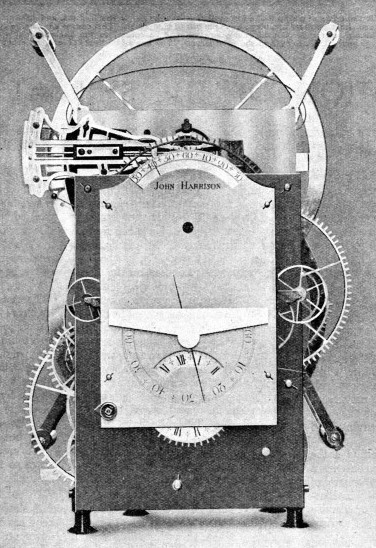 It is much to be hoped that the four Harrison timekeepers which belong to the nation will always be maintained — as, most certainly, is the present intention of the authorities — in going order, and going. Their importance in the history of navigation is difficult to exaggerate. They constitute the finest possible memorial, one far more appropriate than any statue or any tablet in Westminster Abbey could possibly be, to the memory of a man who made the whole world his debtor — a man who was most truly great.
It is much to be hoped that the four Harrison timekeepers which belong to the nation will always be maintained — as, most certainly, is the present intention of the authorities — in going order, and going. Their importance in the history of navigation is difficult to exaggerate. They constitute the finest possible memorial, one far more appropriate than any statue or any tablet in Westminster Abbey could possibly be, to the memory of a man who made the whole world his debtor — a man who was most truly great.
GREAT ELABORATION OF DETAIL is a feature of Harrison’s No. 3 chronometer, which weighs 66 lb. and has 753 separate parts. It took seventeen years to make, and its complete overhaul, begun in 1924, occupied seven years.
You can read more on
“Instruments of Navigation”, “Navigational Charts” and
on this website.